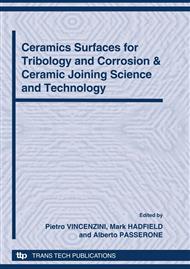p.83
p.88
p.98
p.108
p.115
p.125
p.135
p.145
p.151
Finite Element Modeling of Thermal Stress in ITER Prototype Optical Windows and its Influencing Parameters
Abstract:
Glass-metal joints are needed for the optical windows in ITER to perform diagnostics. These joints must be leak tight for the safety (presence of tritium in ITER) and to preserve the vacuum. They must also withstand the ITER environment: temperatures around 250 °C and neutron fluxes of 109 n/cm2.s. At the moment, little information is available about glass-metal joints suitable for ITER. Therefore, we set-up a 2D elastic model of prototype Al diffusion bonded optical windows using Abaqus code to model temperature effects on the windows. With this model we analyzed the influence of different parameters like the joint area and the braze thickness on the mechanical properties of the joint. Calculations of the thermal stress created by a temperature field of 150 °C (normal ITER temperature) showed that the Al-bond is the weakest part of the window. To find a way of reducing the thermal stress, the influence of some parameters has been studied. In particular, a specific thickness of the Al layer can result in a minimum of stress in the Al bond while the joint area and the thickness of the glass have only a small influence on the stress in the windows. The calculations allowed to propose an optimized design for the windows prototypes.
Info:
Periodical:
Pages:
145-150
Citation:
Online since:
October 2010
Keywords:
Price:
Сopyright:
© 2010 Trans Tech Publications Ltd. All Rights Reserved
Share:
Citation:


